Mazda 2: Air Intake Duct
AIR INTAKE DUCT REMOVAL/INSTALLATION
1. Set the air intake mode to REC.
2. Disconnect the negative battery cable.
3. Remove the following parts:
- Glove compartment (See GLOVE COMPARTMENT REMOVAL/INSTALLATION).
- Dashboard under cover (See DASHBOARD UNDER COVER REMOVAL/INSTALLATION).
- Heat duct (RH) (See HEAT DUCT COMPONENT REMOVAL/INSTALLATION).
- Rear console (See REAR CONSOLE REMOVAL/INSTALLATION).
- Shift lever knob (MTX) (See MANUAL TRANSAXLE SHIFT MECHANISM REMOVAL/INSTALLATION).
- Side wall (See SIDE WALL REMOVAL/INSTALLATION).
- Front console component (See FRONT CONSOLE COMPONENT REMOVAL/INSTALLATION).
- Front scuff plate (See FRONT SCUFF PLATE REMOVAL/INSTALLATION).
- Front side trim (See FRONT SIDE TRIM REMOVAL/INSTALLATION).
- Hood release lever (See HOOD LATCH AND RELEASE LEVER REMOVAL/INSTALLATION).
- Lower panel (driver-side) (See LOWER PANEL REMOVAL/INSTALLATION).
- Knee bolster (See KNEE BOLSTER REMOVAL/INSTALLATION).
- Driver-side air bag module (See DRIVER-SIDE AIR BAG MODULE REMOVAL/INSTALLATION).
- Steering wheel (See STEERING WHEEL AND COLUMN REMOVAL/INSTALLATION).
- Column cover (See COLUMN COVER REMOVAL/INSTALLATION).
- Meter hood (See METER HOOD REMOVAL/INSTALLATION).
- Instrument cluster (See INSTRUMENT CLUSTER REMOVAL/INSTALLATION).
- Combination switch (See COMBINATION SWITCH REMOVAL/INSTALLATION).
- Center panel unit (See CENTER PANEL UNIT REMOVAL/INSTALLATION).
- Climate control unit (See CLIMATE CONTROL UNIT REMOVAL/INSTALLATION [MANUAL AIR CONDITIONER] ).
- Shift lever component (MTX) (See MANUAL TRANSAXLE SHIFT MECHANISM REMOVAL/INSTALLATION).
- Selector lever component (ATX) (See AUTOMATIC TRANSAXLE SHIFT MECHANISM REMOVAL/INSTALLATION
- Interlock unit (ATX) (See AUTOMATIC TRANSAXLE SHIFT MECHANISM REMOVAL/INSTALLATION).
- Lower panel (passenger-side) (See LOWER PANEL REMOVAL/INSTALLATION).
- Side panel (See SIDE PANEL REMOVAL/INSTALLATION).
- A-pillar trim (See A-PILLAR TRIM REMOVAL/INSTALLATION).
- Windshield wiper arm and blade (See WINDSHIELD WIPER ARM AND BLADE REMOVAL/INSTALLATION).
- Cowl grille (See COWL GRILLE REMOVAL/INSTALLATION).
- Windshield wiper motor (See WINDSHIELD WIPER MOTOR REMOVAL/INSTALLATION).
- Sail garnish (See SAIL GARNISH REMOVAL/INSTALLATION).
- Steering shaft cover (See STEERING WHEEL AND COLUMN REMOVAL/INSTALLATION).
- Steering shaft (See STEERING WHEEL AND COLUMN REMOVAL/INSTALLATION).
4. Disconnect the dashboard wiring harness connector.
5. Disconnect the antenna feeder No.1 jack.
6. Remove the dashboard. (See DASHBOARD REMOVAL/INSTALLATION).
7. Remove the air intake duct installation bolt.
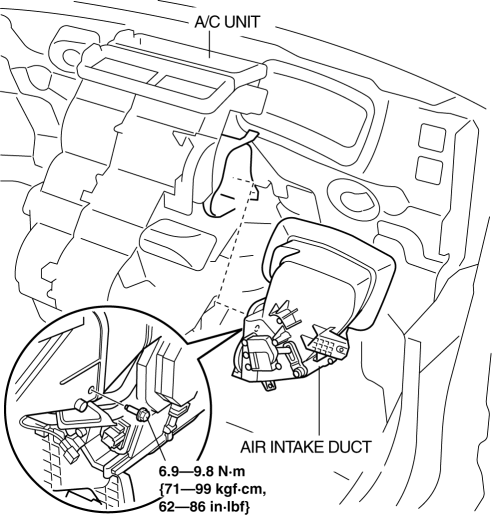
8. Remove the air intake duct.
9. Install in the reverse order of removal.
AIR INTAKE DUCT DISASSEMBLY/ASSEMBLY
1. Disassemble in the order indicated in the table.
CAUTION:
- Apply only the specified grease to links. Otherwise abnormal noise or improper operation may result.
2. Assemble in the reverse order of disassembly.
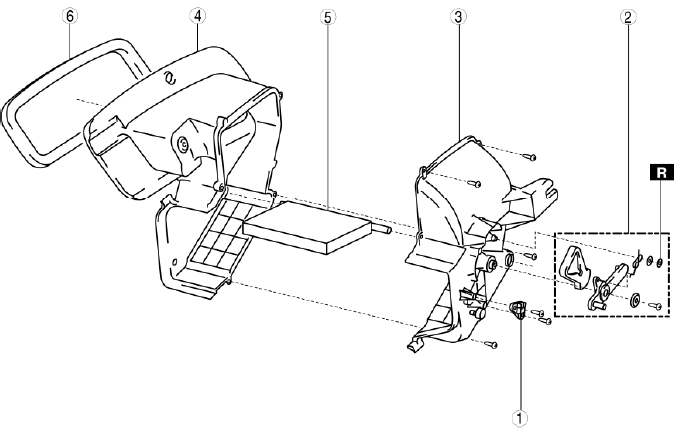
- Wire clamp
- Air intake link set
- Air intake duct case (1)
- Air intake duct case (2)
- Air intake door
- Adhesive polyurethane
Air Intake Duct Case Disassembly Note
1. Align the contacting surfaces of air intake duct case (1) and (2), and cut the adhesive polyurethane.
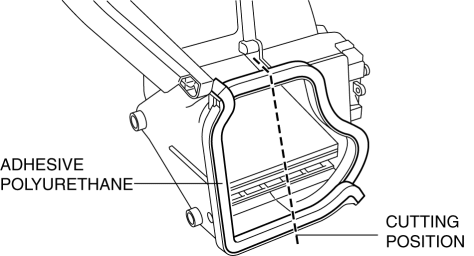
EXPANSION VALVE REMOVAL
1. Disconnect the negative battery cable.
2. Collect the refrigerant. (See REFRIGERANT CHARGING).
3. Remove the air cleaner installation bolt and slide the air cleaner component aside.
4. Remove the cooler hose (LO) installation nut, and then remove the cooler hose (LO) bracket from the vehicle stud bolt.
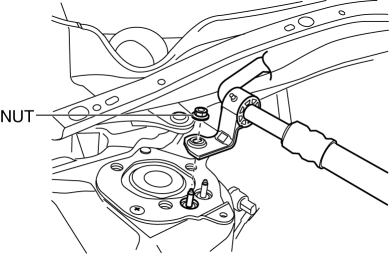
CAUTION:
- If moisture or foreign material enters the refrigeration cycle, cooling ability will be lowered and abnormal noise or other malfunction could occur. Always plug open fittings immediately after removing any refrigeration cycle parts.
5. Using the SSTs (49 B061 014, 49 G061 001) disconnect the cooler pipe and cooler hose from the A/C unit while not allowing the remaining compressor oil in the A/C compressor and pipes to spill. (See REFRIGERANT LINE REMOVAL/INSTALLATION).
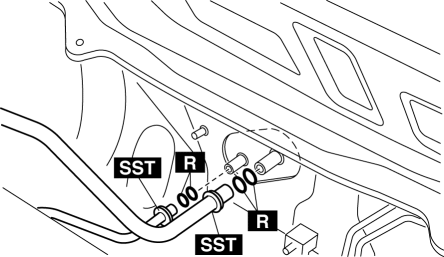
6. Remove the following parts:
- Glove compartment (See GLOVE COMPARTMENT REMOVAL/INSTALLATION).
- Heat duct (RH) (See HEAT DUCT COMPONENT REMOVAL/INSTALLATION).
- Side wall (RH) (See SIDE WALL REMOVAL/INSTALLATION).
7. Disconnect the evaporator temperature sensor connector.
8. Remove the evaporator temperature sensor wiring harness clip.
9. Disconnect the resistor connector.
10. Make a hole in the position shown in the figure for the adhesive polyurethane (2) and remove the outlet pipe installation bolt.
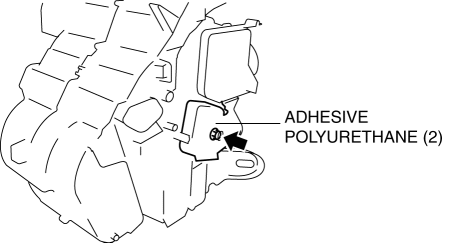
11. Cut the adhesive polyurethane (2) near the contact surfaces of the expansion valve and outlet pipe, and tear it off.
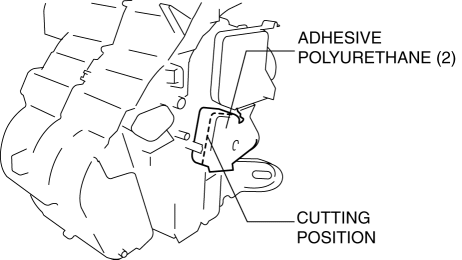
12. Slide the outlet pipe to the right while being careful not to allow remaining compressor oil in the outlet pipe and expansion valve to spill.
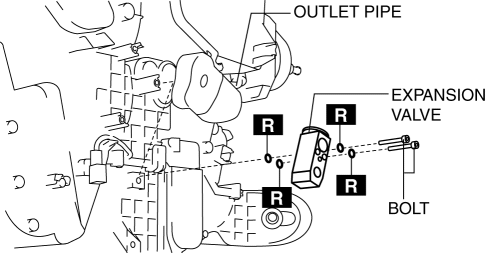
13. Remove the expansion valve installation bolts.
14. Remove the expansion valve while being careful not to allow the remaining compressor oil in the expansion valve and evaporator to spill.
15. Tear off the adhesive polyurethane (2) from the expansion valve.
CAUTION:
- Because of the possibility of condensation forming, whenever possible remove the adhesive polyurethane carefully so that it does not damage the adhesive sponge rubber on the outlet pipe.
16. Cut the adhesive polyurethane (2) as shown in the figure and remove the adhesive polyurethane (2) from the outlet pipe near the expansion valve.
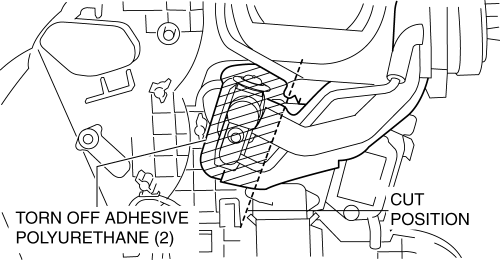
EXPANSION VALVE INSTALLATION
1. Slide the outlet pipe to the right while being careful not to allow the remaining compressor oil in the outlet pipe to spill.
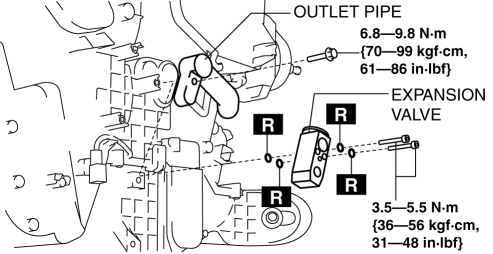
2. Install the expansion valve.
3. Install the outlet pipe.
4. Align the adhesive polyurethane (2) notch with the center of the lower surface of the expansion valve, and adhere.
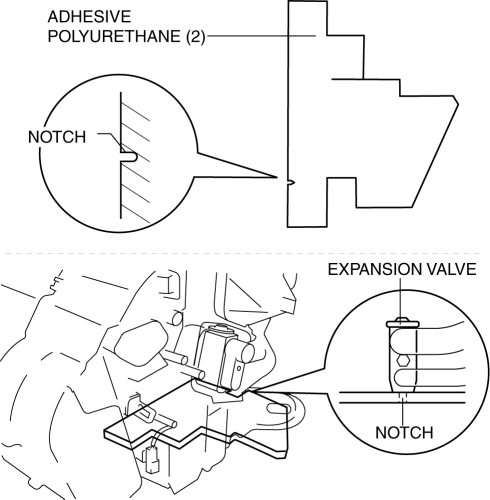
5. Roll on the adhesive polyurethane (2) so that it wraps around the expansion valve.
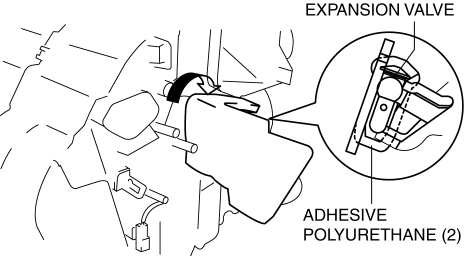
6. Bend around the adhesive polyurethane (2) and adhere it to the outlet pipe.
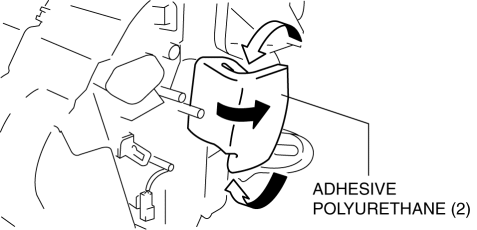
7. Connect the resistor connector.
8. Install the evaporator temperature sensor wiring harness clip.
9. Connect the evaporator temperature sensor connector.
10. Install the following parts:
- Side wall (RH) (See SIDE WALL REMOVAL/INSTALLATION).
- Heat duct (RH) (See HEAT DUCT COMPONENT REMOVAL/INSTALLATION).
- Glove compartment (See GLOVE COMPARTMENT REMOVAL/INSTALLATION).
11. Connect the clutch pipe and cooler hose while being careful not to allow the remaining oil in the pipe and A/C unit to spill. (See REFRIGERANT LINE REMOVAL/INSTALLATION).
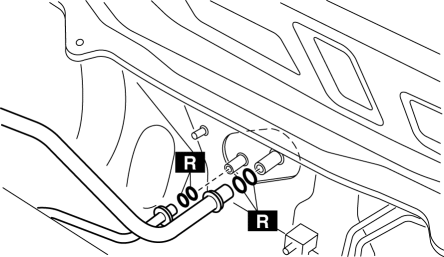
12. Install the cooler hose (LO) bracket.
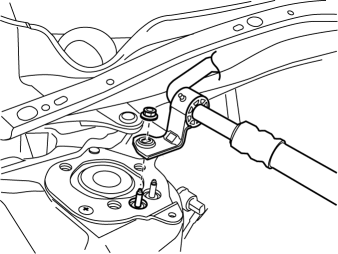
Tightening torque
- 6.9-9.8 N*m {71-99 kgf*cm, 62-86 in*lbf}
13. Install the air cleaner component.
14. Charge the refrigerant. (See REFRIGERANT CHARGING).
15. Connect the negative battery cable.
16. Perform the refrigerant system performance test. (See REFRIGERANT SYSTEM PERFORMANCE TEST).

